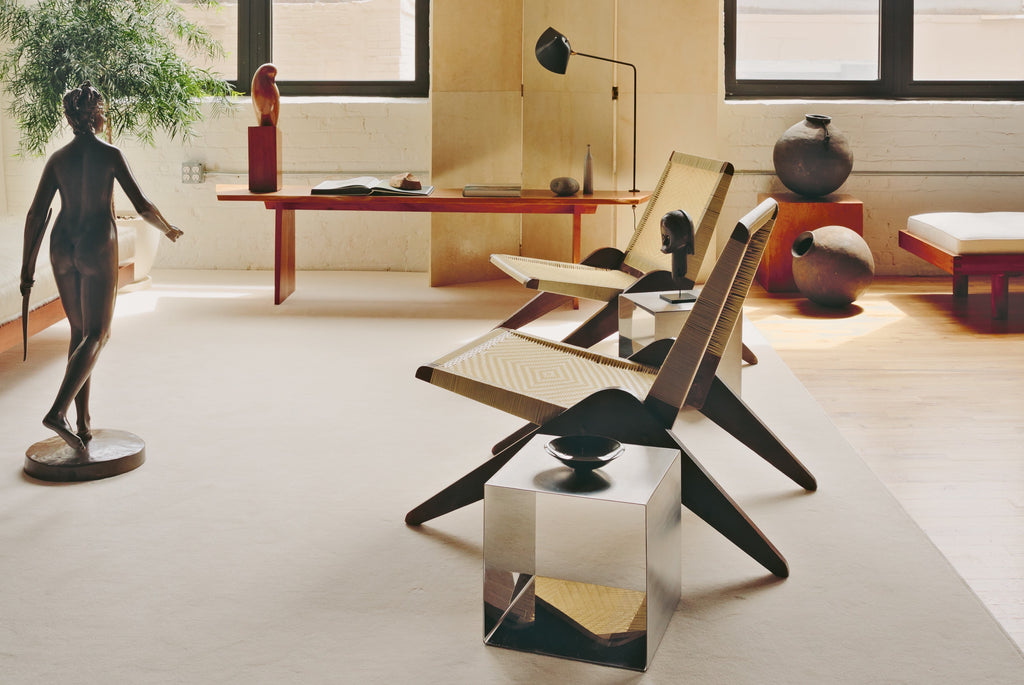Modernity, simplicity, geometry, form and soul: Michael Diaz-Griffith, writer, design leader and author of The New Antiquarians, discovers a timeless space in Brooklyn, New York, the home-atelier of young collectors and gallerists, Avril Nolan and Quy Nguyen.

Suppose you were enjoying dinner at the home of a brilliant young couple you had just befriended. Much good wine was consumed, a fragrant fog hung in the air, and by dessert, their heads—instead of appearing as human heads normally do—appeared to take the form of geometric shapes: his, a sphere, and hers, a cylinder.
Naturally you are startled, and you beat a hasty retreat, waving goodbye to the two queer figures and promising to return again soon. Indeed, you very much wish to do so, yet you find it difficult to leave in the first place, doubled up as you are—with laughter, and a touch of madness—on the sidewalk outside.
Reader, this happened to me, and I put the whole episode down to the particular brilliance of that young couple, Quy Nguyen and Avril Nolan, whose hospitality is matched only by their discerning taste in all things, including fragrant fogs.
Before we proceed, it should be noted that discerning taste, a good thing, is only a remote cousin of “good taste,” a bad thing. Almost invariably, “good taste” tangles us up in received ideas, class prejudices, and all manner of narrowness best avoided by people with souls (that is you, Reader) or those wishing to appear soulful (whom we should pass over in silence).
All images by Bryan W. Ferry, The New Antiquarians: Young Collectors at Home, written by Michael Diaz-Griffith and published by Monacelli, a Phaidon company.
The ability to judge well, on the other hand, carries us away from narrowness and toward expansiveness and encounters with the world’s secret richness. With curiosity, patience, and the will to discern, you can easily identify the best of anything, understanding and comparing the intrinsic qualities of things.
In these qualities, Reader, you will find surprise and delight. Your sense of what is best will be subjective, of course, and changing, but it will be related to what things are: dry, complex, dusty, florid. By contrast, “good taste” tells you nothing about things and everything about people. Left to select the best wine according to the standards of “good taste,” you need only to understand the person sitting across from you.
Quy and Avril are uninterested in that person and have no time for moderately priced bottles of Sancerre. Instead, their interest is in things—and, particularly, objects—possessed of their own undeniable, if subtle, presence.
In their design showroom, Form Atelier, Quy and Avril obsess over quality, color, provenance, and endless other factors, but only if the essential form of a thing beguiles them. That thing could derive from any culture, genre, or era as long as it remains formally seductive when unburdened of its extrinsic qualities or extraneous details. Look around their atelier and you will see dozens of examples: A classical statue. A Shaker chair. A Noh mask. A live-edge table. Just as you are beginning to think it’s all very sculptural, you will spy an Amish quilt, conceived with intense geometric rigor, folded gently in a corner.

Even the wall hangings in their atelier, riffing on a room by Renzo Mongiardino, bespeak Quy and Avril’s fascination with form in its varied dimensions. Unlike traditional European draperies, awash in color and passementerie, these gently swagged panels are all about line.
Approaching the zero degree of design to which pure white walls aspire, yet charged with formal interest, they could be from any place or time. Quy and Avril know precisely when and where they’re from, of course, and they will giddily show you the Mongiardino reference over a glass of natural wine, but that reference is secondary to the enduring integrity— and interest—of a form distilled to its quintessence.
In a world of forms, Reader, you might suspect the air is quite thin. Not so in this one. As we arranged and adjusted the objects you see in these [images], I watched Quy and Avril work with what can only be described as joy. As we discovered visual connections between seemingly disparate things, the measure of joy increased, and the warmth of genuine happiness filled their atelier.
I was reminded of the evening, not long before, when I quaked with laughter (and a touch of madness) on the couple’s sidewalk. Whenever I am with them, I thought, like true connoisseurs, they expose me to the best things.
There is never any pretension, however, and even at its most sophisticated, their discerning taste always seems to be trained on that most innocent aim: pleasure, simple pleasure, in the world’s secret richness.

This article is an excerpt from the book, The New Antiquarians: At Home with Young Collectors, written by Michael Diaz-Griffith and published by Monacelli, a Phaidon company.















































